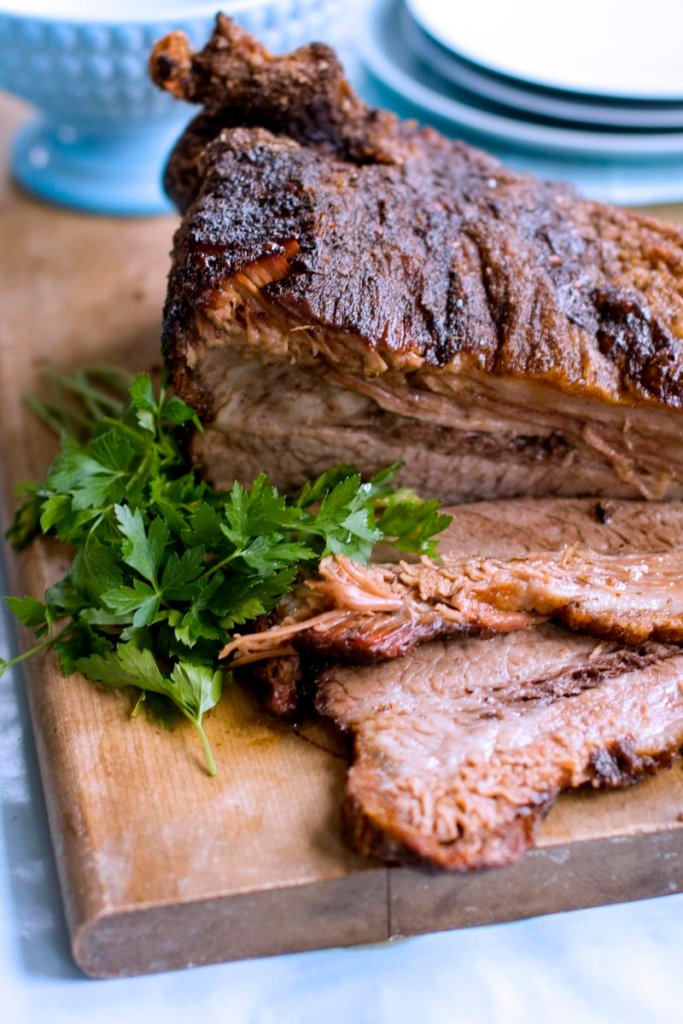A beef brisket supper is associated with many of the Jewish holidays, but perhaps none more regularly than Hanukkah. And there’s a good reason — the festival of lights lasts a full eight days and always includes a Friday night Sabbath meal.
Sure, brisket is an inexpensive yet delicious cut that feeds a crowd and turns meltingly tender when cooked slowly at a low temperature. But it’s that last part that makes it perfect for a Sabbath supper when the cooking needs to be finished before sunset. Brisket is the perfect make-ahead meal.
Other Hanukkah traditions call for dairy meals and, of course, fried foods such as the ubiquitous potato latke to celebrate the legend of the tiny amount of oil that burned for a miraculous eight days in the Jewish temple. But there almost always is a meat-based meal, as well.
Meat guru Bruce Aidells remembers that his grandmother, who kept a kosher home, always had an onion- and carrot-smothered brisket for Hanukkah served alongside crispy potato pancakes. He says there was invariably a roasted chicken served, too.
Aidells, who is author of “The Complete Meat Cookbook,” says his own mother prepared a brisket as well, but braised it in a more traditional fashion using a jar of chili sauce, lots of onions and some onion soup mix for additional flavor in the gravy.
Kosher chef Laura Frankel says she has a hunch that this tradition of braising a brisket is the reason that the roasted chicken often accompanies the meal.
“That brisket shrinks so much when it’s cooked in liquid,” says Frankel, “that all those Jewish mothers out there worried they wouldn’t have enough food, so they would throw a chicken in the oven as well.”
As a result, Frankel, who authored “Jewish Slow Cooker Recipes,” likes to cook her Hanukkah brisket covered, at a very low heat, simply sitting on a bed of vegetables, which she later turns into a sauce with some wine and the drippings. The results, she says, are just as tender as a braise, but with less shrinkage.
Other make-ahead meat meals that Frankel prepares include braised short ribs and a slow-cooker lamb tagine served with sweet potato latkes.
Aidells still has a love for brisket, and though he likes the dry-roasting technique as well, he says braising is a great way to add flavor to the meat. He prefers to use grass-fed beef for its superior flavor. If he’s looking to go leaner, he’ll prepare a bison brisket, which can be purchased from specialty meat shops.
When shopping for a brisket, Aidells says that even when buying the leaner first or flat end of the brisket (the most common cut at grocers), look for some marbling in the meat to ensure tenderness and the best possible flavor.
He also recommends purchasing a brisket with at least a quarter-inch of fat on the top (called the deckle). You may have to ask your butcher to cut it this way, as briskets most often are sold trimmed completely of visible fat.
Our recipe for Hanukkah is a variation on the traditional beer and chili sauce-braised brisket. We use the bottled chili sauce in a nod to tradition, but then intensify the flavors with some strong black coffee and a hearty porter beer. The result is a fork-tender pot roast with rich and flavorful mahogany-colored gravy.
COFFEE AND PORTER BRAISED BRISKET
Start to finish: 31/2 hours (30 minutes active)
Servings: 12
4-pound brisket, flat half, trimmed of fat
1/2 teaspoon salt
Ground black pepper, to taste
2 teaspoons extra-virgin olive oil
2 medium yellow onions, peeled and quartered
6 ribs celery, cut into 1-inch pieces (about 2 cups)
12-ounce bottle chili sauce
Three 12-ounce bottles porter beer
2 cups strong black coffee
Season the brisket with the salt and pepper. In a large Dutch oven over high, heat the oil. Add the brisket and sear until browned all over, 3 to 4 minutes per side. Transfer the meat to a plate and set aside.
Add the onions and celery to the pot, then set the brisket over them. Add the chili sauce, beer and coffee. Bring the mixture to a boil, cover, then reduce the heat to maintain a simmer. Cook for 2 hours.
Uncover and cook until the brisket is fork tender, another 1 to 2 hours. If the liquid reduces too much, replace the cover.
When ready, transfer the brisket to a plate and cover loosely with foil.
Skim any fat off the surface of the braising liquid. Using an immersion blender, puree the vegetables and braising liquid in the Dutch oven. Alternatively, use a ladle to transfer the vegetables and braising liquid, in batches if necessary, to a blender and puree until smooth. Return the sauce to the Dutch oven. Use caution when pureeing hot liquids.
Return the brisket to the Dutch oven with the sauce and heat on the stovetop until the meat is heated through, about 10 minutes. Slice the brisket into thin slices across the grain and serve topped with the sauce.
Send questions/comments to the editors.



Success. Please wait for the page to reload. If the page does not reload within 5 seconds, please refresh the page.
Enter your email and password to access comments.
Hi, to comment on stories you must . This profile is in addition to your subscription and website login.
Already have a commenting profile? .
Invalid username/password.
Please check your email to confirm and complete your registration.
Only subscribers are eligible to post comments. Please subscribe or login first for digital access. Here’s why.
Use the form below to reset your password. When you've submitted your account email, we will send an email with a reset code.